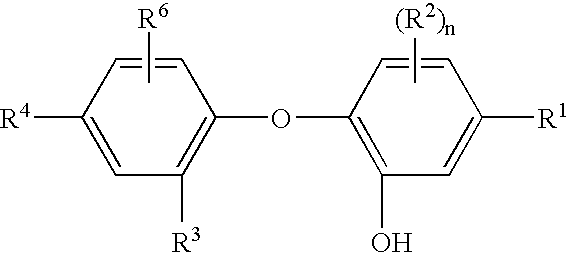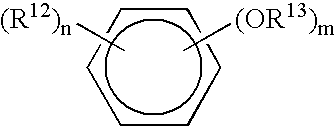Phenolic antiseptic compositions and methods of use
- Summary
- Abstract
- Description
- Claims
- Application Information
AI Technical Summary
Benefits of technology
Problems solved by technology
Method used
Image
Examples
examples
[0260]
TABLE 1Glossary of ComponentsAcronymTrade nameDescriptionSourceAddress2-2-phenoxyethanolAldrichMilwaukee, WIphenoxyethanolEmulsifying80 / 20 IOA / MPEGPrepared asSt. Paul, MNpolymer GG(25 wt-% polymer indescribed below*IPP)DOSSAerosol OT-75docusate sodiumAmericanW. Patterson,CyanamidNJbenzalkoniumbenzalkonium chlorideAldrichMilwaukee, WIchlorideCarbowax 400Polyethyleneglycol 400DOW / UnionDanbury, CTCarbideCarbowax 1450Higher MW PEG, e.g.DOW / UnionDanbury, CT1450CarbideDOSSComplemixdocusate sodium USPICI AmericasWilmington,DEEDTAEDTA disodiumethylene diamineAldrichMilwaukee, WItetraacetic acid,disodiumglyceringlycerin (glycerol)AldrichMilwaukee, WI(glycerol)Hipure 88lactic acid (88 wt-%) inPurac AmericaLincolnshire, ILwaterIncroquatCationic emulsifyingCrodaParsippany, NJBehenyl TMSwaxIrgasan DP300TriclosanCibaTarrytown, NYLurol ASYalkyl phosphateGeorge A. GoulstonMonroe, NCMineral oilMineral oil USPPaddock LabsMinneapolis,MNPCMXOttaseptParachlorometaxylenolLonza / HappiRamsey, NJPluron...
examples 1-5
[0264] Antimicrobial compositions of 250 grams each was were prepared using the components shown in Table 2a. The respective antimicrobials: PCMX, Irgasan DP300 (triclosan), or benzalkonium chloride; were combined with other components: glycerin, Carbowax 400 and Aerosol OT-75 in a glass container and heated in an oven at approximately 70° C. Carbowax 1450 PEG was placed in a second glass container heated to its melting point and then added to the first container. The composition was then swirled by hand to mix and then reheated again to 70° C. The composition was allowed to cool on rollers to approximately 40° C. then transferred into jars, and sealed.
[0265] The control samples showed no antimicrobial efficacy in 2.5 min against the test organisms. These examples, prepared in hydrophilic vehicles, had 2.9 log or greater kill in 2.5 minutes for both MRSA (Gram positive) and E. coli (Gram negative) bacteria. Addition of a lactic acid enhancer to Example 5 improved the antimicrobial ...
examples c3
, C4, 6-9
[0266] Control Examples C3 and C4, containing no antimicrobial agents, as well as antimicrobial compositions, Examples 6-10, were prepared in amounts of 250 grams each using the components shown in Table 2b for each example. Petrolatum was added to a glass container and heated in an oven to approximately 70° C. All other components were added to a second glass container and also heated in an oven at approximately 70° C. Just prior to mixing the contents of the two containers together, Aerosol OT75 (where applicable) was first added to the second container. The mixture of all components was then mixed using a high shear rotor / stator Silverson homogenizer on high speed for 1 minute. Mixing was continued at low speed using a Gast overhead air mixer with radial flow impeller until just before the composition congealed at approximately 40° C. The compositions were removed from the mixer, poured into jars, and sealed.
[0267] Examples 6 and 7 are compositions having a hydrophobic ...
PUM
| Property | Measurement | Unit |
|---|---|---|
| Temperature | aaaaa | aaaaa |
| Time | aaaaa | aaaaa |
| Percent by mass | aaaaa | aaaaa |
Abstract
Description
Claims
Application Information
 Login to View More
Login to View More - R&D
- Intellectual Property
- Life Sciences
- Materials
- Tech Scout
- Unparalleled Data Quality
- Higher Quality Content
- 60% Fewer Hallucinations
Browse by: Latest US Patents, China's latest patents, Technical Efficacy Thesaurus, Application Domain, Technology Topic, Popular Technical Reports.
© 2025 PatSnap. All rights reserved.Legal|Privacy policy|Modern Slavery Act Transparency Statement|Sitemap|About US| Contact US: help@patsnap.com



